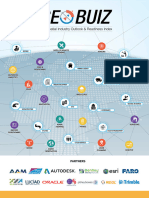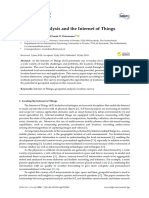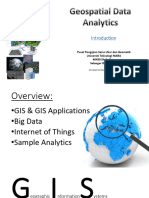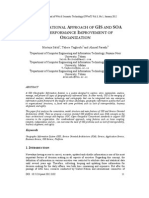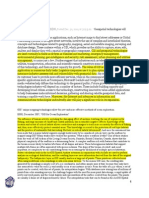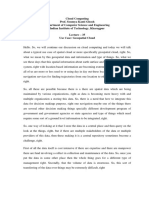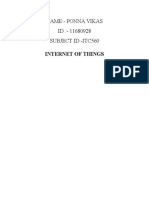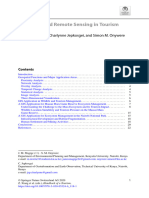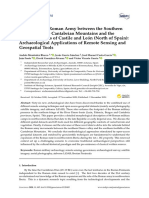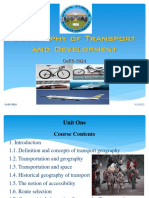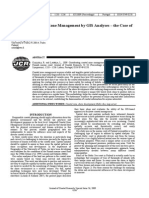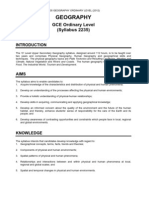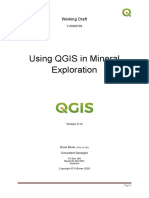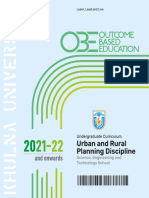Significance of geospatial data analytics
Sensors and devices that can provide geographic data and other information that can help businesses
perform geospatial analytics and visualizations using graphs and charts or by plotting the data on
interactive maps. There’s significant opportunity in such data. For example, businesses can use
geospatial analytics to increase the reach of their products, obtain meaningful insights to their
operations, better assist their customers, provide interesting features as enhancements to their
products based on regional preferences, improve product quality and reliability, and so on. The
challenge is processing IoT geospatial data in a way that extracts maximum value.
Interestingly, the biggest portion, (70.5%) of IoT connected devices will be in
business/manufacturing and healthcare. Within these and other market sectors, connected devices
with fixed and moving sensors will be the source of vast amounts of real-time and near real-time
data. On its own, the sensor data tells an interesting story, but it’s one dimensional. When combined
with geospatial analytics, business data, and operational data, the data can reveal hidden patterns
and relationships that deliver better business outcomes.
Companies within the insurance, travel, agriculture, and construction industries are enriching data
from IoT sensors with business applications and geographic data from GIS. They are overlaying
business data, device location information, customer locations and more with detailed geographic
information, like topography and satellite imagery. Rich graphics, such as heat maps and charts help
users visualize business activities, relationships, and patterns.
IoT in the field
In commercial agriculture, farmers are overlaying maps of their fields with historical data and sensor
data to produce crops more efficiently. Through an app, they can take a virtual walk-though of any
sector and understand exactly what is happening with their crop.
Sensors in the soil measure moisture, pH, and more to show farmers the state of their soil. A crop
history shows past planting schedules and harvests. From a dropdown list, scheduled and
unscheduled tasks display irrigation, fertilization, planting, spraying, and harvesting timelines.
Farmers can schedule these tasks and assign a contractor to complete them.
�When a crop needs irrigating, for example, the farmer first tests the land’s moisture. The sensors
can tell him the exact percentage of moisture in the land at 6 am, 1pm and 5pm. He can look at
records from last year at this same time, and he can run a quick analysis to see what the moisture
should be three days, two days and one day before planting a crop of wheat. If rain is in the forecast,
the farmer can cancel the contractor and avoid an unnecessary expense.
IoT in the sky
Likewise, in the travel industry, geolocation apps and IoT data can be the ticket for cost savings and
improved operations. With the right geospatial analytics solution an airline could track global flight
operations more closely and accurately with spatial capabilities by monitoring airport,
meteorological, and fleet data in real time to improve its flight planning solution and optimize fuel
and staff costs. Thousands of flights can be tracked each day on a 3D mapping interface that displays
spatial and temporal coordinates. Flight delays based on hurricanes, volcano eruptions, or other
major travel inhibitors can be rerouted based on the data’s projections.
IoT assesses risk
In another interesting example one of the world’s largest reinsurance companies uses spatial data
processing, predictive analytics, and simulation capabilities to assess risk based on hurricanes,
wildfires, tornadoes, and other weather-related events. The company is tapping into a cloud-based
earth observation analysis service to analyze natural disaster data with its customer data to make
more informed decisions about insurance risks.
Airlines can use the sensors in airplanes to understand a plane’s exact location, better prepare for
delays, divert flights in case of weather or airport issues, better plan the routes to maximize usage
and reduce costs, and more. Geographical data from various sources can also provide real-time
statistics on popular destinations, identify regions with the most delays, or even customize
experiences based on specific regions.
Manufacturing companies can use real-time data with geospatial components to better understand
demands based on regions and use those insights to reduce logistic costs and improve delivery. For
example, an organization that manufactures vehicles can use geospatial data obtained from sensors
�in their vehicles to identify the right regions to establish service centers to better serve their
customers.
Retail businesses can use geospatial data to analyze which products sell better based on specific
regions and channelize their marketing in those regions based on popular demand. This insight can
also help retail companies understand the likes and dislikes of the market in that region and predict
demand to manage inventory.
Healthcare can be improved using geospatial data from sensors in several ways. Geospatial data
can help identify the exact location of a patient and thereby help direct quick medical care. It can
also be used to identify and prepare for epidemics, track staff-to-bed proximity to enhance patient
care, and more.
Agriculture can benefit from weather pattern analysis, insights that help farmers identify the right
crop to grow in specific regions, or preparation for disasters like droughts or floods. Geospatial data
can help agricultural businesses protect the yield, create more efficient distribution networks to
maximize profits, and improve logistic capabilities to avoid food waste.
Companies looking to take advantage of their geospatial and IoT data typically want to process this
data in real time or near real time. Doing so allows them to generate and update charts, reports, and
maps as quickly as possible without having to incur huge infrastructure costs or the operation costs
of maintaining a dedicated team. At the same time, they need to be able to make changes to these
processes with relative ease as more data types or logic need to be incorporated. Here are some of
the specific challenges you need to overcome when you’re working with this type of data:
Volume: Geospatial data analytics can include huge amounts of data that need to be
processed in order to retrieve useful information from them. You need to process huge
volumes of data in shortest possible amount of time and perform complex calculations on
them while keeping the costs for processing reasonable.
Variety: Geospatial data is available in a variety of formats. Depending on the nature of the
data, you may need to define a process that reads in data from all these different source
formats, cleans the data to extract only relevant information so it can be consumed by open-
source tools and libraries, and perform conversions if needed to simplify the analytics and
maintain a simple logical layer.
� Storage and retrieval: Efficiently storing and retrieving geospatial data can be another
challenge, but it’s essential to reducing the cost involved in performing complex operations.
Indexing geospatial data is also vital, since it helps simplify operations like constructing
hierarchical data types out of simpler data structures or filtering data at an earlier stage to
reduce the amount of data needed for analysis. It’s also important to optimize the storage
medium to improve search capabilities within geometric constructs, like search for points
that represent a city within a multi-polygon that represents a continent.
Representation: Representation of geospatial data can also be a major challenge. You need
to define a geodetic datum to convert the three-dimensional location information of earth
into a more easily readable and processable two-dimensional format.
Scale and accuracy: The scale and precision on which geographic data needs to be
represented also plays a vital role in determining the level of accurate analysis that can be
derived from the data. Some algorithms need extremely accurate geographic data to provide
precise results, and collecting and representing this data can prove to be a major challenge.










